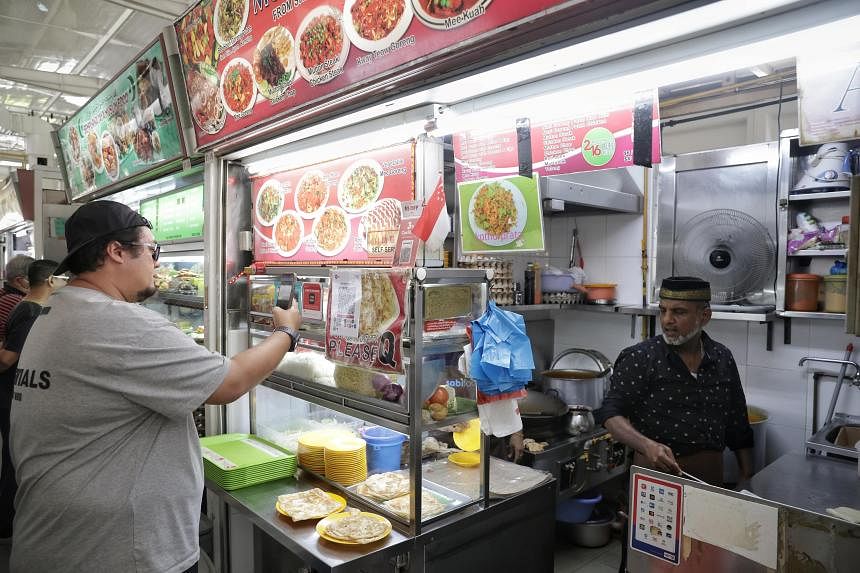SINGAPORE – Stallholders in food centres who have yet to adopt cashless payment systems have an additional year to hop on board with the help of subsidies.
The government subsidy waives the 0.5 per cent transaction fee that stallholders will have to pay for each digital transaction – those made via QR code payments under the Singapore Quick Response Code (SGQR) platform.
The new subsidy window, under the Hawkers Go Digital initiative to spur more merchants to digitalise, is now until Dec 31, 2024 – the second time it has been extended. It was initially extended to the end of 2023 to support stallholders during the Covid-19 pandemic.
So far, 11,000 stallholders have registered since the initiative was launched by Enterprise Singapore and the Infocomm Media Development Authority in 2018, Senior Minister of State for Communications and Information Tan Kiat How told the media on Thursday during a visit to Block 216 Bedok Food Centre and Market.
The initiative aims to bring on board as many of the 18,000 or so stallholders under government-run food centres, such as those operated by the National Environment Agency and Housing Board, before the subsidies are lifted, said Mr Tan, when asked about the initiative’s targets.
“When I speak to many of the hawkers, they find it brings a lot of convenience,” he said, adding that e-payment reduces the cash that operators need to carry.
Even when the subsidy is lifted at the end of 2024, the 0.5 per cent transaction fee is below the industry norm, said Mr Tan. “So, for example, if you sell a plate of chicken rice for $4 or so, that’ll be about two cents.”
He added that the SGQR platform has facilitated some 5.4 million transactions worth a total of $45 million in August alone.
This is more than 15 times the amount transacted when the subsidy was first extended in June 2020.
When asked if alerts from the authorities about QR code scams and the rise in scam cases here have shaken confidence in digital payments, Mr Tan said steps have been taken to address such concerns.
“One of the early concerns, especially among elderly hawkers, is that they will get scammed. They weren’t sure whether the customer had paid... So we put in place systems that will signal to them when payment is received,” said Mr Tan, referring to a notification system that will display transactions or indicate payments received with a “beep”.
Ambassadors have also been deployed to guide stallholders and patrons on best practices, he added.
Around 80 per cent of stallholders at the Bedok food centre have registered for SGQR services, said Mr Tan. SGQR allows users of various payment platforms such as PayNow, GrabPay, Touch ‘n Go and WeChat Pay to scan and pay using the same QR code.
Drinks stall employee Brandon Lim said he applied for SGQR earlier in October and will set up the payment platform soon, after customers expressed interest in using QR payment to receive discounts.
But some other stallholders may need convincing.
Mr Nazeerkhan Abdulwahab, who also works at a drinks stall, said most of his customers are seniors who do not use e-payment. He set up a ShopBack QR code payment earlier in October, but no one has used it so far, he said.
He added that he is unlikely to consider SGQR to avoid incurring any additional cost when the subsidies are lifted.
“There’s not much business here anyway and if we have to raise prices, our customers will go next door, so it’s not for us,” said Mr Nazeerkhan, 33.
Vegetarian stall owner Lim Seng King, 35, has subscribed to the SGQR platform, but chose not to display the QR code.
“It’s too troublesome,” he said in Mandarin. “Most seniors don’t use it and sometimes, there’s an outage... Up to 10 people a day ask me if I have QR payment, but it’s only a few. I’d rather use cash.”
Bedok resident Hsin Chiang Koon, 60, said recent scams have shaken his trust in digital platforms, so he feels that cash is still the safer option. “I’m afraid of people peeking at my phone behind me when I key in my passcode or tricking me somehow,” he said.
Muslim food stall operator Jamila Mohamad Noor, 59, who adopted digital payments during the pandemic, however, said e-payment has made transactions swifter.
She said: “Now everything just goes to the bank, so I don’t need to settle so much cash. Most younger people use the QR code to pay, so it’s very convenient.”
She intends to stick with SGQR, even after the subsidy ends, as long as the additional costs do not affect business too much and if she does not need to raise prices to cope.
“I can’t really afford to increase prices here, my customers will make noise,” said Madam Jamila, who has worked at the stall since the 1970s.


